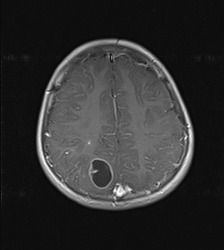#dysembryoplastic neuroepithelial tumors
Explore tagged Tumblr posts
Text
youtube
#Epilepsy#LEAT#brain tumors#ganglioglioma#dysembryoplastic neuroepithelial tumors#DNET#seizure development#antiepileptic drugs#tumor-associated epilepsy#neuro-oncology#seizure management#surgical resection#epilepsy pathophysiology#diagnostic challenges#low-grade tumors#neurology#quality of life#clinical neuroscience#prognostic factors#emerging therapies.#Youtube
0 notes
Text

Next, we will consider supratentorial pediatric brain tumors, starting with the most common low-grade tumors: low-grade astrocytoma (LGA), pleomorphic xanthoastrocytoma (PXA), dysembryoplastic neuroepithelial tumor (DNET), and ganglioglioma. LGAs have variable appearance at MRI, but do tend to have mild enhancement. PXAs tend to have a large cyst with an enhancing solid component, but can have multiple cystic areas, and as such the imaging features overlap with gangliogliomas which tend to have multiple cystic areas. DNETs have cystic and solid components without robust enhancement. PXAs and ganglioglioma have a predilection for the temporal lobe, DNETs for frontal or temporal, and LGAs can occur anywhere (but favor the supratentorial brain). Today’s case is a 10-year-old boy who presented with 4-month history of headache and seizure. MRI reveals a cystic lesion with an enhancing nodule in the right parietal lobe. This was a PXA. See our post from July 8, 2023 for an example of a ganglioglioma.
Case courtesy of Luis Felipe Camarillo, Radiopaedia.org, rID: 94934
#TeachingRounds#FOAMed#FOAMRad#pediatrics#neurology#pedsrad#pedsneuro#neurosurgery#radiology#neuroradiology#peds
1 note
·
View note
Text
Occurrence of high‐grade glioma in Noonan syndrome: Report of two cases
Abstract
Noonan syndrome (NS) is an autosomal dominant disorder commonly caused by PTPN11 germline mutations. Patients are characterized by short stature, congenital heart defects, facial dysmorphism, and increased risk of malignancies including brain tumors. Commonly associated brain tumors are dysembryoplastic neuroepithelial tumor and low‐grade glioma. We report two cases of anaplastic astrocytoma with PTPN11‐related NS. We conducted a systematic search of medical databases looking for other reported cases of high‐grade glioma associated with NS and identified 24 cases of brain tumors, all of which were low‐grade glial or glioneuronal tumors except for one case of medulloblastoma.
http://bit.ly/2B96MwJ
0 notes
Text

Cortical tumors (arising from gray matter) have a unique differential diagnosis - oligodendroglioma, ganglioglioma, pilocytic astrocytoma, and dysembryoplastic neuroepithelial tumor (DNET, rare in adults). This is a rare location for metastasis.
Patients with cortical tumors typically present with seizures. Today’s case is a 45-year-old woman with a 15-year history of seizure disorder. At brain MRI she was found to have a predominantly cystic cortical tumor in the right temporal lobe with minimal contrast enhancement. This was a ganglioglioma.
Image credit: radiologyassistant.nl
#TeachingRounds#FOAMed#FOAMRad#Neurology#Radiology#Neurosurgery#Oncology#Neuroradiology#NeuroOncology#cancer#Neurorad#MRI#MRIRad
1 note
·
View note